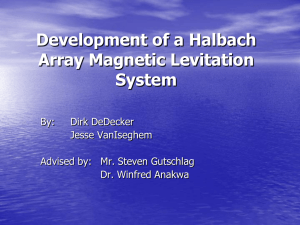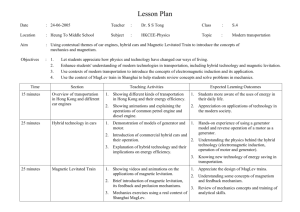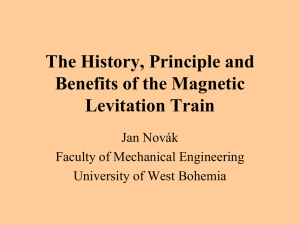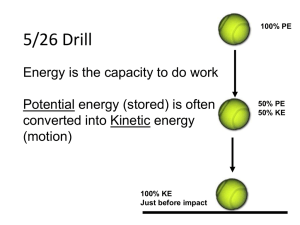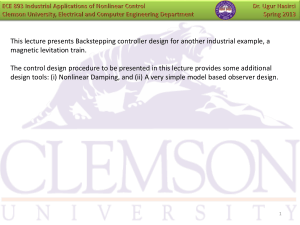Toward More Efficient Transport: The Inductrack Maglev System Advanced Transportation Workshop
advertisement
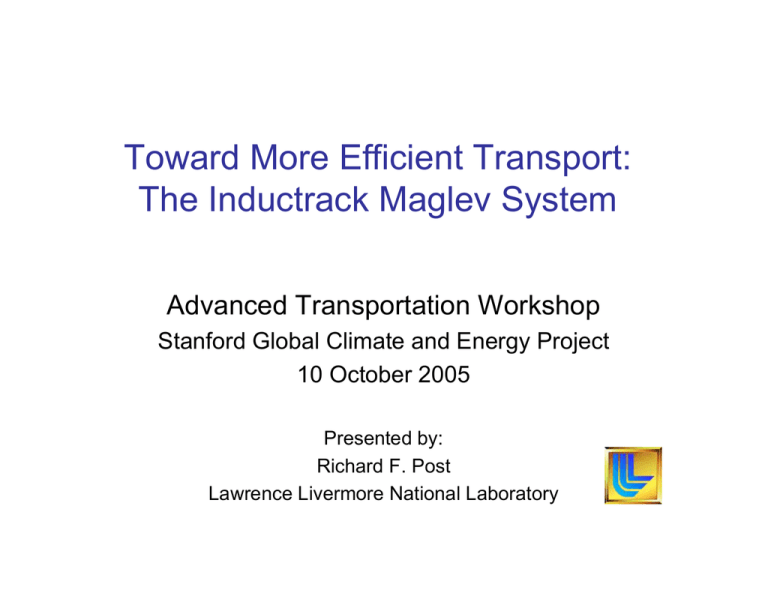
Toward More Efficient Transport: The Inductrack Maglev System Advanced Transportation Workshop Stanford Global Climate and Energy Project 10 October 2005 Presented by: Richard F. Post Lawrence Livermore National Laboratory There are many reasons why magnetically levitated trains could be preferred over conventional transit systems • • • Inter-city transportation: Much higher speeds than are possible with steel-wheeled trains, lower noise, greater passenger comfort, increased safety against mechanical failures, reduced maintenance. Relative to aircraft: Higher energy efficiency, safer, less weather-dependent, and would permit in-city departure and arrival. Urban transit systems: Lower noise, much lower maintenance, greater rider comfort, can climb steeper grades, higher energy efficiency than conventional urban transit systems. GCEP-02 Two different types of Maglev trains have been built and demonstrated at full scale at speeds up to 500 km/hr • • • • GCEP-03 Magnetic attraction - EMS (Electro-Magnetic Suspension) systems, using servo-controlled electromagnets on the train car, attracted upward to a iron-plate rail. Magnetic repulsion -EDS (Electro-Dynamic Suspension) systems, using cryogenically cooled superconducting magnets on the moving car, repelled by currents induced in coils embedded in “tracks” on each side of the train. Example EMS system: The German Trans-Rapid TR08 demonstration train and 30 kilometer test track, with operating speeds up to 450 km/hr. Example EDS system: The Japanese Yamanashi demonstration train, with speeds of 500 km/hr on a 18 kilometer test track. The German Trans-Rapid maglev train is an EMS system using electromagnets attracted to an iron “rail” Iron-plate "rail" Gap: 1 cm ± 1 mm To control amplifier GCEP-04 Iron magnet yoke (on train car) To control amplifier The German Trans-Rapid maglev train uses powered electromagnets attracting upward to an iron rail GCEP-05 The Japanese Yamanashi demonstration maglev train uses superconducting magnets on its sides GEP-06 There are identifiable steps to take en route to increasing the energy efficiency of maglev systems • Eliminate or minimize the energy requirements of the on-board levitation system. • For EDS systems, maximize the efficiency of the “track” system through track design and through optimizing the on-board levitation system. • Maximize the efficiency of the propulsion system as far as is possible consistent with cost considerations. • Minimize aerodynamic drag. GCEP-07 The LLNL “Inductrack” maglev system developed as a spin-off from the Lab’s flywheel energy storage program • • • • • GCEP-08 It is an EDS system, but uses only permanent magnets and does not require cryogenically cooled superconducting coils It is a passive system that requires no electromagnets or control circuits to maintain stable levitation Levitation off of the auxiliary wheels occurs as soon as a low “lift-off” speed is reached. The Inductrack system is”fail safe” in the event of a power failure; the train car would simply slow down and settle down on its auxiliary wheels at a low speed. The simplicity of the Inductrack should make it substantially less expensive than the present EDS or EMS maglev trains. LLNL Flywheel Technology and Applications Integrated System Composite rotor GCEP-09 The Inductrack system optimizes levitation efficiency, using permanent magnets and a passive “track.” • Special arrays (Halbach arrays) of permanent magnets are employed, mounted on “bogies” underneath the car. • The periodic magnetic fields from the magnet arrays on the moving train car induce currents in a closepacked array of shorted electrical coils in the “track” to produce levitation (above a low “transition” speed). GCEP-10 In the 1980’s Klaus Halbach came up with better ways to employ permanent magnets in focusing particle beams • The Halbach array makes optimal use of permanentmagnet material by concentrating the field on the front face of the array, while nearly canceling the field on the back face of the array • The magnetic field near the front face of the array varies sinusoidally with position parallel to the face of the array, and falls off exponentially with distance away from the front face. • Only permanent-magnet material is employed in Halbach arrays; no “back iron”elements or iron poles are needed. GCEP-11 The moving Halbach array magnets induce currents in the close-packed shorted circuits embedded in the track End view of Halbach array Upper conductors of short GCEP-12 on moving car ed levitation circuits in track The levitating force becomes effective at very low vehicle speeds and remains constant at high speeds Fraction of Maximum Levitation Force vs Speed Fraction of Maximum Lift Force 1.0 0.8 0.6 Transition speed (1.2 km/hr) 0.4 0.2 0.0 0 5 10 15 Speed (km/hr) GCEP-13 20 25 30 The Laboratory is a member of a team that is designing an urban maglev system employing the Inductrack approach. • The team (which also includes several engineering firms in the Pittsburgh, Penn. area), was organized by General Atomics (San Diego) and is funded by the Federal Transit Administration. • The advantages of maglev in urban settings (relative to conventional urban rail systems) include: Lower noise, lower maintenance, higher efficiency, higher grade and tighter turn capabilities (allowing operation on elevated tracks that can accommodate to an urban environment without the need for underground-tunnel operation). • Better to satisfy urban (moderate speed) applications we have developed the Inductrack II configuration, which greatly reduces electromagnetic drag forces at urban speeds (relative to Inductrack I, which is an alternative for high-speed applications). GCEP-14 The Inductrack II maglev employs dual Halbach arrays, reducing drag losses and enhancing levitation forces • • • • GCEP-15 A cantilevered ladder track is used, interacting with two facing Halbach arrays, one above, and one below the track. The horizontal component of the magnetic fields from the upper and lower Halbach arrays are additive, while the vertical field of the lower array opposes that of the upper array. By adjusting the thickness or the width of the magnets of the lower array relative to the upper array an optimum level of induced levitating current can be achieved for a given levitated weight and magnet weight. Either a litz-cable “ladder track” or slotted, laminated, sheet conductors with fiber composite reinforcement could be used to construct the cantilevered track. Adjusting the relative height of the Inductrack II Halbach arrays optimizes the levitation force vs drag power Levitation height Vert. field null GCEP-16 The General Atomics urban maglev system employs The Inductrack II dual-Halbach-array configuration Vehicle on Guideway Linear Synchronous Motor Suspension Track Double Sided Magnet Array GCEP-17 A full-scale levitation/propulsion test track is in operation at General Atomics in San Diego GCEP-18 After using the Inductrack II array to optimize the on-board levitation efficiency, the next step is to optimize the “track” Laminated stack of slotted thin copper or anodized aluminum sheets “Ladder Track” “Laminated Track” (Litz-wire cables, soldered into bus bars at ends and encapsulated in stainless-steel cans Stack of thin copper or aluminum sheets, slotted to produce an array of conductors shorted at ends GCEP-19 The LLNL Inductrack levitation computer code was employed to compare performance of the tracks Litz track with stainless-steel cans Laminated track with composite cladding Parameters: Magnet area: 3.6 m2, levitation gap: 25.0 mm., track width: 0.5 m., Litz track: 20 mm. x 20 mm. litz cables, packing fraction: 0.7, center-to-center: 25 mm., stainless-steel can thickness: 2.0 mm. Laminated track: 2.0 mm. wide, 1.0 mm thick conductor strips, 20 mm. thick conductor bundle GCEP-20 A “Laminated-Track Test Rig” was built at LLNL to benchmark the Livermore Levitation Code The track is pulled through dual Inductrack Halbach arrays mounted in a housing that is equipped with guide rollers, force sensors, and a speedtachometer GCEP-21 There is good agreement between the predictions of the Levitation code and the Test Rig results Lift and drag force predictions of Levitation code compared to Test Rig measurements for a dual Halbach array. (Upper and lower curves are for ± 1.0 mm displacement of track.) GCEP-22 Lift/Drag curves provide a measure of levitation efficiency* of the Inductrack as compared with conventional systems 700 600 500 400 Lift/Drag Ind. II 300 Steel rail 200 100 0 *Aerodynamic losses not included GCEP-23 Ind. I 0 100 ° ° 200 300 ° Jet airplane 400 Velocity (km/hr) Rubber-tired train maximizing maglev energy efficiency requires both high levitation efficiency and high propulsion efficiency • • • • Maglev systems such as the G-A Inductrack urban maglev system and the Japanese HSST employ linear synchronous motors (LSMs) for propulsion. LSMs operate by using inverters to drive high ac currents through 3-phase windings embedded in the track. To keep the resistive energy losses within acceptable bounds, the “block length” of these windings must be limited, using “block switches,” adding to the cost and complexity of the system. In connection with a NASA-sponsored study at LLNL of the rocketlaunching capabilities of Inductrack, Ed Cook of the Laboratory has developed a modular pulsed LSM drive that promises much higher efficiency than that possible with conventional LSM drive systems. GCEP-24 In a conventional LSM maglev propulsion system the inverter must drive long winding cables at high current GCEP-25 The modular pulsed LSM-drive system uses costeffective condensers and solid-state components D energy recovery SCR D4 L sr * Maglev Drive Coils SCR2 D2 IGBTchg L chg Control Circuit Power Supply L sf * D3 SCR3 D1 SCR1 Saturable Inductor D freewheeling Cs *L sr , L sf - if required to adjust pulse width Circuit 1 SCR1 & SCR2 Circuit 2 SCR3 & SCR4 Note: The SCRs in Ckt 1 and Ckt 2 each drive separate and independent windings EGC 9/10/01 GCEP-26 Controlling the phasing of the pulses allows either acceleration or deceleration (with energy recovery) Metersêsec Vel. decrease vs time 0.1 0.2 0.3 0.4 0.5 0.6 0.7 - 0.0002 - 0.0004 - 0.0006 - 0.0008 - 0.001 - 0.0012 φ0 = 0.0 radians Aver. accel. = 1.05 m/sec2 Drive efficiency = 0.86 GCEP-27 φ0 = π radians Aver. decel. = 1.2 m/sec2 Recovery eff. = .81 ms. Summary and Conclusions • • • • • • GCEP-28 Urban and inter-city maglev systems could represent a practical and energyefficient solution to pressing transit needs. To maximize the energy efficiency of maglev systems both the levitation means and the propulsion system must be optimized. A candidate system is the Inductrack, employing permanent magnets on the moving vehicle to achieve levitation. Based on analytic theory and benchmarked computer codes optimized design parameters for urban and inter-city Inductrack transit systems have been presented. A generic urban version of the Inductrack is under development by General Atomics in San Diego, en route to its deployment and use in a public transit system in Pennsylvania. Other applications of the Inductrack concept have been considered, such as “people movers,” and efficient and speedy inter-city transport of high-value (Fed-Ex-like) freight in evacuated tubes.

